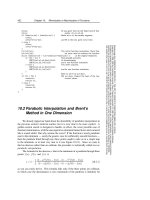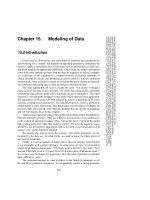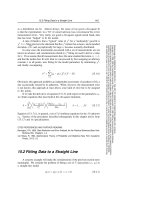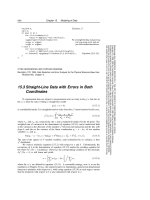Tài liệu Evaluation of Functions part 11 pdf
Bạn đang xem bản rút gọn của tài liệu. Xem và tải ngay bản đầy đủ của tài liệu tại đây (132.54 KB, 2 trang )
5.10 Polynomial Approximation from Chebyshev Coefficients
197
Sample page from NUMERICAL RECIPES IN C: THE ART OF SCIENTIFIC COMPUTING (ISBN 0-521-43108-5)
Copyright (C) 1988-1992 by Cambridge University Press.Programs Copyright (C) 1988-1992 by Numerical Recipes Software.
Permission is granted for internet users to make one paper copy for their own personal use. Further reproduction, or any copying of machine-
readable files (including this one) to any servercomputer, is strictly prohibited. To order Numerical Recipes books,diskettes, or CDROMs
visit website or call 1-800-872-7423 (North America only),or send email to (outside North America).
5.10 Polynomial Approximation from
Chebyshev Coefficients
You may well ask after reading the preceding two sections, “Must I store and
evaluate my Chebyshev approximation as an array of Chebyshev coefficients for a
transformed variable y? Can’t I convert the c
k
’s into actual polynomial coefficients
in the original variable x and have an approximation of the following form?”
f(x) ≈
m−1
k=0
g
k
x
k
(5.10.1)
Yes, you can do this (and we will give you the algorithm to do it), but we
caution you against it: Evaluating equation (5.10.1), where the coefficient g’s reflect
an underlying Chebyshev approximation, usually requires more significant figures
than evaluation of the Chebyshev sum directly (as by chebev). This is because
the Chebyshev polynomials themselves exhibit a rather delicate cancellation: The
leading coefficient of T
n
(x), for example, is 2
n−1
; other coefficients of T
n
(x) are
even bigger; yet they all manage to combine into a polynomial that lies between ±1.
Only when m is no larger than 7 or 8 should you contemplate writing a Chebyshev
fit as a direct polynomial, and even in those cases you should be willing to tolerate
two or so significant figures less accuracy than the roundoff limit of your machine.
You get the g’s in equation (5.10.1) from the c’s output from chebft (suitably
truncated atamodest value of m)bycallinginsequencethe followingtwoprocedures:
#include "nrutil.h"
void chebpc(float c[], float d[], int n)
Chebyshev polynomial coefficients. Given a coefficient array
c[0..n-1]
, this routine generates
a coefficient array
d[0..n-1]
such that
n-1
k=0
d
k
y
k
=
n-1
k=0
c
k
T
k
(y) −
c
0
/2.Themethod
is Clenshaw’s recurrence (5.8.11), but now applied algebraically rather than arithmetically.
{
int k,j;
float sv,*dd;
dd=vector(0,n-1);
for (j=0;j<n;j++) d[j]=dd[j]=0.0;
d[0]=c[n-1];
for (j=n-2;j>=1;j--) {
for (k=n-j;k>=1;k--) {
sv=d[k];
d[k]=2.0*d[k-1]-dd[k];
dd[k]=sv;
}
sv=d[0];
d[0] = -dd[0]+c[j];
dd[0]=sv;
}
for (j=n-1;j>=1;j--)
d[j]=d[j-1]-dd[j];
d[0] = -dd[0]+0.5*c[0];
free_vector(dd,0,n-1);
}
198
Chapter 5. Evaluation of Functions
Sample page from NUMERICAL RECIPES IN C: THE ART OF SCIENTIFIC COMPUTING (ISBN 0-521-43108-5)
Copyright (C) 1988-1992 by Cambridge University Press.Programs Copyright (C) 1988-1992 by Numerical Recipes Software.
Permission is granted for internet users to make one paper copy for their own personal use. Further reproduction, or any copying of machine-
readable files (including this one) to any servercomputer, is strictly prohibited. To order Numerical Recipes books,diskettes, or CDROMs
visit website or call 1-800-872-7423 (North America only),or send email to (outside North America).
void pcshft(float a, float b, float d[], int n)
Polynomial coefficient shift. Given a coefficient array
d[0..n-1]
, this routine generates a
coefficient array g
[0..n-1]
such that
n-1
k=0
d
k
y
k
=
n-1
k=0
g
k
x
k
,wherexand y are related
by (5.8.10), i.e., the interval −1 <y<1is mapped to the interval
a
<x<
b
. The array
g is returned in
d
.
{
int k,j;
float fac,cnst;
cnst=2.0/(b-a);
fac=cnst;
for (j=1;j<n;j++) { First we rescale by the factor const...
d[j] *= fac;
fac *= cnst;
}
cnst=0.5*(a+b); ...which is then redefined as the desired shift.
for (j=0;j<=n-2;j++) We accomplish the shift by synthetic division. Synthetic
division is a miracle of high-school algebra. If you
never learned it, go do so. You won’t be sorry.
for (k=n-2;k>=j;k--)
d[k] -= cnst*d[k+1];
}
CITED REFERENCES AND FURTHER READING:
Acton, F.S. 1970,
Numerical Methods That Work
; 1990, corrected edition (Washington: Mathe-
matical Association of America), pp. 59, 182–183 [synthetic division].
5.11 Economization of Power Series
One particular application of Chebyshev methods, the economization of power series,is
an occasionally useful technique, with a flavor of getting something for nothing.
Suppose that you are already computing a function by the use of a convergent power
series, for example
f(x) ≡ 1 −
x
3!
+
x
2
5!
−
x
3
7!
+ ··· (5.11.1)
(This function is actually sin(
√
x)/
√
x, but pretend you don’t know that.) You might be
doing a problem that requires evaluating the series many times in some particular interval, say
[0, (2π)
2
]. Everything is fine, except that the series requires a large number of terms before
its error (approximated by the first neglected term, say) is tolerable. In our example, with
x =(2π)
2
, the first term smaller than 10
−7
is x
13
/(27!). This then approximates the error
of the finite series whose last term is x
12
/(25!).
Notice that because of the large exponent in x
13
, the error is much smaller than 10
−7
everywherein the interval except at the very largest values of x. This is the feature that allows
“economization”: if we are willing to let the error elsewhere in the interval rise to about the
same value that the first neglected term has at the extreme end of the interval, then we can
replace the 13-term series by one that is significantly shorter.
Here are the steps for doing so:
1. Change variables from x to y, as in equation (5.8.10), to map the x interval into
−1 ≤ y ≤ 1.
2. Find the coefficients of the Chebyshevsum (like equation 5.8.8) that exactly equals your
truncated power series (the one with enough terms for accuracy).
3. Truncate this Chebyshev series to a smaller number of terms, using the coefficientof the
first neglected Chebyshev polynomial as an estimate of the error.









